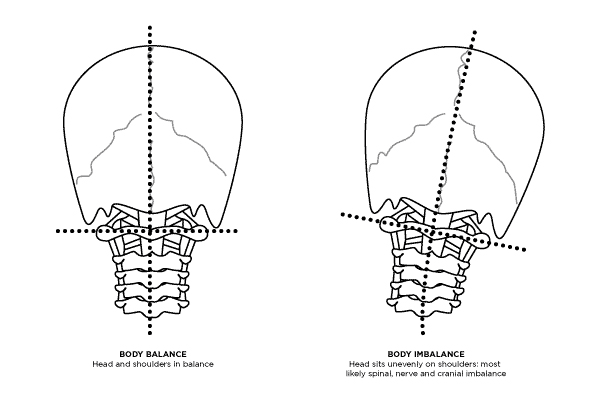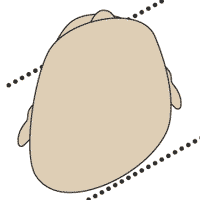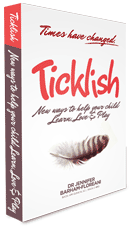 Have you noticed that your baby or infant has a flat spot on their head? That the overall head shape seems uneven? It may be worth a little more attention…
Have you noticed that your baby or infant has a flat spot on their head? That the overall head shape seems uneven? It may be worth a little more attention…
Sometimes parents of young children ask if there is anything that chiropractors can do regarding their child’s head shape. The short answer is YES. Chiropractors understand the intricacies of the human nervous system and the impact that a misshapen head can have on the feedback system between the brain and the rest of the nervous system. While a child’s head shape may look awkward and unappealing, chiropractors remind parents there are other very important issues at hand.
It’s imperative that parents appreciate that a misshapen head is not merely a cosmetic issue; it is most likely a brain stem issue. If your child’s head looks uneven or you notice flat areas, this may indicate restrictions between the skull and the soft layers that cover the brain and spinal cord. A healthy brain requires good movement of the skull, the dura or protective layers surrounding the brain, and the spine itself. When this movement is impaired or restricted in anyway, brain and nerve function may also be impaired.1
Sometimes children have nerve and spinal distress that results in their head being tilted to one side so that one ear sits higher than the other (refer to picture below). At other times a child’s head may be rotated or turned more to one side, so that they display a preference for having their head turned this way. This may impact the baby’s ability to breast feed effectively and to fully integrate the wider world around them.
There is a myth that an odd-shaped child’s head is of no concern and will ‘right itself’ with time, however, anomalies of shape may be one of the first indications that your child is susceptible to developmental delay.1,2

How Would a Child’s Skull and Spine Get out of Shape?
1) Lack of Alignment of the Mothers Pelvis
Literature shows that misalignments of the spine and skull may be caused during pregnancy due to a mother’s pelvic distortion (misalignment of the bones of the pelvis) or the position of the baby within the uterus.3 Previous accidents (e.g. motor vehicle, cycling), falls (e.g. off horses, down stairs) or poor postures may have allowed the joints in the mother’s pelvis to move into awkard positions. When the joints of a mother’s pelvis do not sit correctly, the layers of muscles, ligaments and other connective tissue that surround a growing baby may be pulled out of position, creating an uneven tightening of the uterus and limiting how a baby moves within the pelvis. As a baby grows bigger their movement may become significantly inhibited as the tissues become more restrictive.
As a baby grows bigger this restriction of movement may create more distress for the developing spine and nervous system. This restriction of movement may also impact feedback to the baby’s brain stem and how they learn in the womb through moving their limbs or their whole body.
2) Birth Trauma
Spine and nerve distress can arise from restricted or abnormal positioning in the uterus and also from the journey through the birth canal or during the delivery process itself.
According to Gutmann,4 a researcher who examined the effects of the birth process, “the trauma from the birth process remains an under-publicized and therefore significantly under-treated problem.”
There are many factors that can cause birth trauma, including false labour, a long or very short labour, failure of the mother’s cervix to dilate, the use of drugs to increase contraction intensity, the use of vacuum extraction or forceps, caesarean section delivery, cord around the baby’s neck and foetal distress.
While nerve irritation can be caused with assisted deliveries, even straightforward vaginal births can create vertebral subluxations if the baby’s head and neck are not tucked under fully to allow for even distribution of the forces associated with labour contractions.
3) Other Physical Traumas
A newborn’s spine is extremely vulnerable and poor handling by adults or older siblings may be another cause for vertebral subluxation. Sometimes mother/baby duo’s fall asleep whilst breastfeeding in bed and the babies head and neck may lie in an awkward, propped up position by the mothers arm, for extended periods of time possibly creating strain on a newborns spine and musculature. Unfortunately accidents can also happen where babies may fall from change tables or prams or adults who are carrying babies may slip and fall.
In fact, subluxations occur throughout life, particularly as we learn how to walk, ride and climb. Other physical causes for subluxations include accidents during contact sports, activities such as skate-boarding and surfing, sustained postures with electronic equipment and poor posture in general.
I highly recommend whether your child’s head is odd-shaped or not and whether their head sits unevenly or not, to have their skeletal system and nervous system checked as early as possible by a chiropractor skilled with babies and children. A chiropractor’s focus is not aesthetics; their aim is to help increase the neurological function of your child.
“If young bodies are in bad shape, what about the brains that are attached to them?”
—Jane Healey PhD
Yours in health,
Jennifer Barham-Floreani
Bach. Chiropractic, Bach. App Clinical Science
Registered internationally, no longer practicing as a chiropractor in Australia.
P.S. For further information please see Ticklish – New ways to help your child Learn, Love and Play (below)…
. . .
1, 2) Miller RI,Sterling k, et al. Plagiocephaly and Learning Delay.Pediatrics. Vol 105. No 2 Febuary 2000
3) Fallon J. Chiropractic and Pregnancy : A Partnership for the Future. ICA Review. Nov/Dec 1990: 39-42
4) Gutmann, G. 1987. Blocked atlantal nerve syndrome in babies and infants. Manuelle Medezin, 25: 5-10.


 Have you noticed that your baby or infant has a flat spot on their head? That the overall head shape seems uneven? It may be worth a little more attention…
Have you noticed that your baby or infant has a flat spot on their head? That the overall head shape seems uneven? It may be worth a little more attention…

